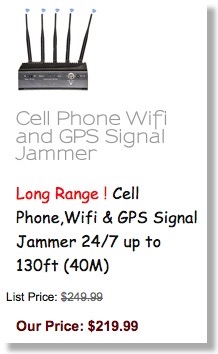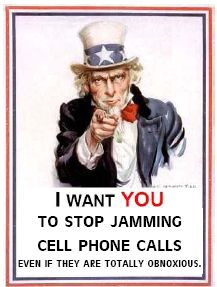Jamming Enforcement at FCC Picks Up
On April 9, FCC approved and released two Notices of Apparent Liability (NAL -- effectively fines) for use of cellular jammers. The one shown above was to Taylor Oilfield Manufacturing, Broussard, Louisiana for $126,000. The other was to The Supply Room, Inc., Oxford, Alabama for $144,000. OUCH!!!
(Now before you sell your stock in these companies your should know that FCC is always in a poor position to collect the full amount of such NALs from anyone able to hire an attorney unless the local US Attorney is really interested in getting fully involved. This can be problematical in many parts of the US.)

The NALs have the following text
Signal jamming devices operate by transmitting powerful radio signals that overpower,jam, or interfere with authorized communications. While these devices have been marketed withincreasing frequency over the Internet, with limited exception, they have no lawful use in the UnitedStates. (A footnote clarifies that federal agency use is a separate issue.)
Your blogger fully agrees that since FCC has never authorized any jamming, the import and use of such equipment is illegal. However, they also have the following text:
In order to protect the public and preserve unfettered access to emergency and other communications services, the Act generally prohibits the importation, use, marketing, manufacture, and sale of jammers.
This sentence is a more complicated issue and sounds more like CTIA’s interpretation of Section 333, the subject of CTIA’s 2007 petition that FCC has never acted on. (The petition also contained the issue of “cellular boosters” which was addressed and finally resolved in Docket 10-4 a few months ago.)
The issue of what Section 333 of the communications Act really means is also addressed in GTL’s July 2011 petition which is sitting without action in FCC’s petition “black hole”. Thus CTIA has repeatedly stated that Section 333 forbids FCC from even considering authorizing jamming in any context including nonfederal high security prisons. Somehow CTIA and NTIA have concluded this nonobvious reading of Section 333 does not affect NTIA at all. As GTL points out, this ignores the “inconvenient truth” that Section 305 only exempts federal use from Sections 301 and 303 of the Act and also that the analogous terms of 18 USC 1367, dealing with the special case of satellite jamming and passed contemporaneously with Section 333, explicitly excludes jamming by federal agencies while Section 333 is silent on special treatment of federal users.
But there is no question here that the new FCC NALs are consistent with the law.
Why were these 2 small private companies spending money on cellular jammers? Here is some explanation from the texts of the NALs:
The manager also claimed that Taylor Oilfield utilized the jamming devices to prevent its employees from using their cellular phones while working, apparently following a near miss industrial accident that allegedly was partially attributable to employee cell phone use.
The general manager also confirmed that Supply Room utilized the jamming devices to prevent its employees from using their cellular phones while working.
This is typical of the cellular industry’s lack of attention to the unintended consequences of its technology, In 2005 (the then existing) Motorola commissioned a study by Don Norman on “Minimizing the annoyance of the mobile phone: The Annoyance, Irritation, and Frustration of The Mobile Phone -- A Design Challenge”. Unfortunately today’s cellular industry doesn’t seem too interested in such issues. They do not view them as a “design challenge” rather as legal issues that must be acted on to help their industry.
From Comm Law Blog

All complex new technologies have unintended consequences. As cellular expands the unintended consequences of these systems are becoming more visible. Shouldn’t the cellular industry address those issues more in addition to demanding more spectrum and more jammer enforcement?




![Validate my RSS feed [Valid RSS]](valid-rss-rogers.png)

